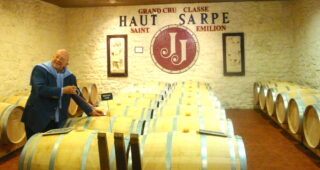Guillaume Deglise has his hands full. The recently appointed (Sep 2013) CEO of Vinexpo is actively helming two expositions this year- one in Hong Kong (Vinexpo Asia Pacific from 27-29 May ) and the other in Japan (Vinexpo Nippon in Nov). Established in 1981 at Bordeaux, France, Vinexpo is the largest gathering of wine and spirits professionals from around the world aimed at promoting the trade, as also to addressing socially relevant issues such as responsible and balanced consumption of alcohol.
Guillaume, with the Chairman Vinexpo M. Xavier de Eizaguirre was in New Delhi this March to present the 5 yearly forecast report for the alcoholic beverages trade, that Vinexpo periodically commissions with International Wine and Spirits Research (IWSR) – an apex trade body situated in London. I had the opportunity to interact with him one-on-one at the über chic Royal Club Lounge at Hotel Leela Palace, courtesy Mr Rajiv Singhal, Vinexpo’s key person in India and one of the most well known Indians on the international wine scene. Here are the excerpts of the conversation:

Me: It is momentous to have two expositions in a year. When do we see a Vinexpo happening in India.
Guillaume Deglise (GD): To be frank, it could be a while. The Indian market is growing fast and generating a lot of interest in the global wine and spirits community, but in terms of volumes it still has a lot of catching up to do. For example if the Chinese consumption of wine per year is estimated at 171 mn cases by 2017, for India it is just 2.1 mn cases. Having said that, the projected growth rate on Indian consumption (73.5% in the period 2013-17) has a lot to cheer about and I suppose when the cost benefit analysis is favourable, we will be happy to host a Vinexpo here.
Me: I have interacted with some exporters from Europe who opine that the current hotshots of the Asian market are witnessing a saturation in demand and so, emerging markets like India are likely to be the new poster boys of the trade. Do you concur with it?
GD: China in some ways has seen saturation but that has been mainly in the higher end wines like the Bordeaux Cru Classé. This is apparently due to the fact that there have been new importers in that country who have not taken the industry quite seriously. However, I think that the market in China will get more structured and we may well be just at the beginning of what the Chinese market will be in the coming times. Japan on the other hand is a very sophisticated market and cannot possibly be compared to China. The Japanese economy is doing extremely well and hence the Japanese market has been continuously growing. So overall, the entire Asia Pacific market is a promising prospect and momentary dips in trade are not a very big concern .
Me: What is the status of South Korea in this milieu?
GD: South Korea could be considered as being between China and Japan, and is a much smaller market. It is getting quite structured as well and we expect a good growth rate there too.

Me: In case of India, spirits is considered a more lucrative market as compared to wine. What is your opinion on this?
GD: Yes, in India, spirits is a huge market and fuelled mostly by the domestic industry. But it is significant that India also happens to be the fifth largest importer of spirits worldwide- tipped to become the fourth largest by 2017, overtaking Thailand. As far as volumes are concerned, it would be unfair to compare the two ( 373.5 mn cases of spirits vs 2.1 mn of wine) so the rightful parameter to adjudge the progress would be the growth rate and wine has a bright future in India going by that.
Me: There have been speculations since long that the import duties on alcoholic beverages in India are likely to be slashed by up to one thirds of the current level -thus benefitting the business and the consumer equally. However, during one of my interactions with a key person in the Federation of Indian Chamber of Trade and Commerce and Industry (FICCI) – a premier trade body of India, it came to the fore that unless the European Union (EU) agrees on certain ‘give and take’ concessions demanded by the Indian side, this may well remain a speculation. Could Vinexpo organization facilitate this understanding by making the right noises to the decision makers in the EU?
GD: Well, Vinexpo could do very little in this respect- to be honest, since we are not a lobbying agency to the EU. We obviously have some connections with the main federations internationally but it is not the role of Vinexpo to interfere in the political issues. However we are following all these discussions very closely and are ready to contribute in any way we can.
Me: But if this were to happen, I see both the trade and the consumer benefitting tremendously.
GD: Of course! In fact, coming back to your first question of the possibility to conduct Vinexpo in India, a better Return on Investment will be the key consideration for companies to come here to showcase their products, and a friendly trade structure would definitely be desirable for that.
Me: So I derive that my first question (of holding a Vinexpo here) is higher on the ambition side in the present day context.
GD: (laughs) Yes, but ambition is a must to make things possible at the first instance.

Me: Post inclusion of some Eastern European nations (e.g. Romania and Bulgaria) into the EU , the wine quality and trade in these countries has witnessed a quantum jump primarily due to technology and investments flowing in, as also planting of international grape varietals in place of some less than average local varietals. Is there a possibility of such an inflow taking place from the EU towards the APAC region so as to dramatically boost the wine quality and trade here?
GD: Investments and technology is already flowing into this region by virtue of collaborations with renowned groups like LVMH and Pernod-Ricard. Also, expert consultants are being engaged individually by wineries, so there isn’t really a restriction on the expertise and funds being available. I think all such collaboration is bound to further increase with the increase in business thus resulting in the same benefits accruing as you have mentioned.
Me: But in India, winemaking is largely concentrated in the Deccan plateau region, which may be just a tip of the iceberg given the size of the country and the vast terroiravailable. I particularly believe that some regions in the lower Himalayan ranges may prove excellent for making wines if a proper study is done. Don’t you think there is lots more that could possibly be done in collaboration with experienced winemakers from the Old World?
GD: It would be difficult for me to comment unless a proper feasibility study is carried out in this respect. In my opinion it may be challenging to produce very high quality wines in many regions of India due to its tropical climate.
Me: The region I am talking about has average temperatures ranging from 5-20 ° C and is quite similar climatically to certain wine producing regions in Europe- except for the monsoon phenomenon- but then there are some rain shadow areas too.
GD: Is there any tradition of fruit producing in these regions?
Me: Certainly! There are lots of tree fruits like apples, peaches, apricots and pears being produced in large quantities in these areas. Even fruit based wines are being produced by certain estates in these regions.
GD: I think it could be worth exploring then. But I would re-emphasize that a comprehensive study on the terroir elements would have to be the first step in this direction.
Me: An interesting conclusion I have drawn from the IWSR study report commissioned by Vinexpo is that in the period 2008-13, Australia, Chile and Italy have become the leading exporters to India with impressive growth rate but France has slipped down. In case of Australia and Chile, this statistics is plausible because of the inherent ease of identification of New World wines by the label. However, from the Old World, Italy gaining two folds and France ceding nearly 22% is a matter of intrigue. What would you attribute this trend to?
GD: It is probably because the wine consumption in the past few years has been growing but not exploding. Surely France has let some market share slip by to other countries and it is because the Indian people are getting more and more interested in wines and they want to taste different things. But France is still exporting to India more than the double of what Italy does. In the present Indian context, the imported wines are driven by Australia by volume and France by value, with countries like the US, Argentina and Chile making significant progress.
Me: Counterfeit wines are a big issue in Asia Pacific to the extent that in one of the years, the annual production of a Grand Cru estate was outstripped by sales of the same vintage in China alone. Is Vinexpo taking some proactive steps in controlling this scourge of the wine industry?
GD: We have periodically been cautioning all producers against this menace by giving out as much information as we can. We have been having conferences during various expositions and will continue doing so. It’s very important for us to provide a deep insight to the wine trade about the latest happenings in the market place. I would also like to add that most of the Grands Crus have already organized their own defence against counterfeit wines by taking a number of initiatives like putting in place, a mechanism to identify a real label from a fake one.
Me: Lastly, what is your take on hi-tech gadgets steadily proliferating the wine world? For example, there is a particular gadget called “Coravin” originally designed for the medical industry that now realizes wine being drawn from a sealed bottle without having to pull out the cork. Do you think it is a welcome development or is it making wine drinking too much of a mechanical experience as some people think?
GD: I believe that wherever technology is enabling wine appreciation, it is a progressive step. In case of the gadget you have mentioned, it may be a good means to appreciate wine by the glass without compromising on the storage life . Personally speaking, I would like to use it.
********
Vinexpo Asia-Pacific, Hong Kong will take place from 27- 29 May 2014 at the Hong Kong Convention and Exhibition Centre.
To register online for the event, visit www.vinexpoasiapacific.com











1 Comment
Great going Colonel Joe! Wishing you all the best and look forward to being part of these tours sometime…best, Abhimanyu!